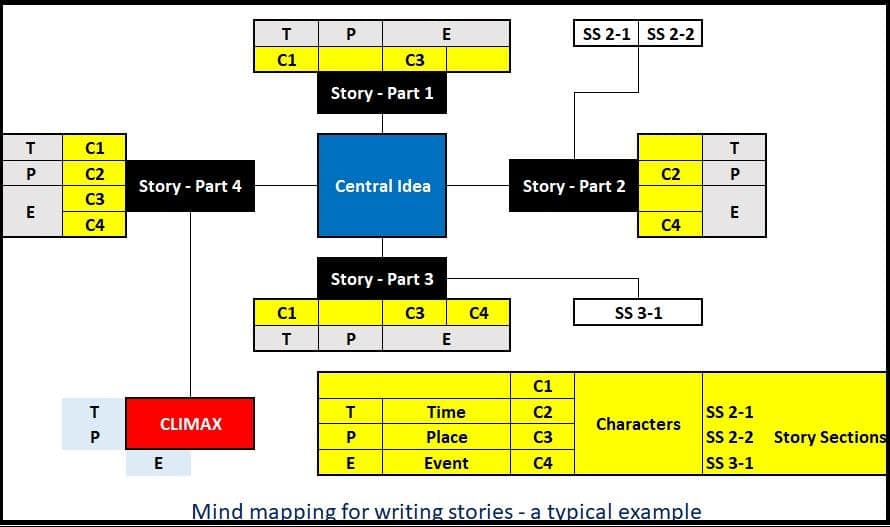Last updated on March 11th, 2023 at 01:14 pm
‘Mind mapping for writing’ means providing aids to your mind to write. You create visual aids (in the form of a diagram) for the brain. These visual aids help the mind to go ahead with writing an essay, a story or say, a novel.
Perhaps the inertia of rest as described in Newton’s laws of motion applies to the human brain too. The mind rises from a state of laziness and works productively only after getting some kind of support.
When we have created a mind map to write with, we see the directions clearly. As the entire piece-to-be is divided logically into sections, the mind concentrates on writing one particular section at a time.
Opening Image by Gerd Altmann from Pixabay
Page contents
Who Will Gain From This Article?
Perhaps you’ve heard about writer’s block. Why does it occur? Because a kind of deadlock forms inside the mind due to continuous work or utter confusion of facts, figures, and logic. Those who suffer from this, may resort to mind mapping for writing.
In addition, a newbie writer, a student, or a seasoned writer as well may need a writing plan. What else is the so-called mind map? A plan. Yes, you need it in some form or another.
What Does ‘Mind Mapping for Writing’ Mean?
Mind mapping is everywhere. You may create a mind map to study a vast topic.
What do you do? Write the principal concept at the center and let the sub-concepts emanate from it. In turn, further tertiary concepts may branch out from the secondary concepts. This helps immensely in reading, understanding, and retaining the entire topic.
You may choose to go in a similar way about writing a piece. When you’ve sketched the mind map, writing out the units becomes easy, and you sum the parts in the end.
How Does the Mind Mapping Help?
It will increase your productivity. If you currently write 2 articles a week, it will definitely double it, if not more. Plus, as you can apply your writing acumen fully to the individual sections, you will definitely improve your writing skills in terms of quality as well.
You’ll easily understand the mind mapping writing process detailed here. Even so, you’ll need some examples to read and some exercises for creating mind maps and writing therewith. So, I recommend reading to the finish line.
What is the Mind Mapping Writing Process?
Mind mapping for writing consists in writing the theme or the measure idea and then building in parts. In the simplest maps, we first write down the theme in the center. After this, we create 3-5 main blocks. Each block contains a writing unit that will partially help conclude the theme.
Each block of the theme is, if the need be, further sub-divided into sections. Thus the writer is able to focus on the details of each block.
All the divisions and subdivisions help in writing the minutest parts of the topic according to a writing plan. It is up to the writer to decide how the primary and tertiary blocks will be connected to each other.
Each of the blocks and the sub-blocks contributes towards depicting the theme in its entirety. When we’re done with all the blocks and their connections, the theme comes to life in the true sense.
An Example of Mind Mapping for Writing Stories
A typical mind map for a story could look like the one below.
The story will have 4 main parts.
There are 4 characters symbolized by C1, C2, C3 and C4. Some or all of them may be present in a part of the story.
The map also reminds to mention the time, place and the event of each part of the story.
The main parts may branch out into sub-sections. For example, you may observe the sub-sections SS 2-1, SS 2-2 etc. Typically, SS 3-1 means the first sub-section that originates from events in Story – Part 3.

You may further see that the climax of the story emerges from the 4th part of the story.
You can make your map more illustrative by writing comments that result due to your discussions with others. However, many writers like to deal with simple mind maps.
How to Write a Short Story Outline -The Fast and Easy Way
Develop the Mind Map Diagram Further
Let’s have a look at how the above mind map shapes up into a typical story. An example might look like this:
Central Idea
An unfortunate event happened. An old woman heard a piece of bad news. She died of a massive heart attack.
Secondary blocks
a. Where
In a nearby residential area.
b. When
In the afternoon, the day before yesterday.
c. Why
Because the old woman heard that her daughter had been fired from her job.
d. Characters
-
- C1 – Satyajit – Demised woman’s son
- C2 – Devanti – Satyajit’s sister
- C3 – Paritosh – A news reporter
- C4 – Saadhan – A union leader
e. The Climax or the Unfolding
The readers comes to know who’s behind all this. Else, what does the protagonist do in the end?
Story Advances From the Mind Map
The following is the first step towards the advancement of the story in steps:
✍🏾 Satyajit used to stay separately with his wife and kids. His mother and elder sister lived in their paternal house.
✍🏾 One day, Satyajit had a bitter quarrel with Paritosh, a news reporter, who wanted to capture some snaps of an unauthorized shoe market.
✍🏾 As the step smelled of some bad intention, the shopkeepers got irked and beat Paritosh. In the heat of the moment, Satyajit, who owned a shop in the market, and Paritosh abused each other.
✍🏾 Police appeared on the scene. To protect her brother, Satyajit’s elder sister Devanti tried to mediate but got entangled badly in the chaotic happenings. Saadhan, a friend of Paritosh, added fuel to the fire by uttering bad words for Devanti.
✍🏾 Devanti, got arrested due to sheer bad luck. Soon her company fired her from her job. The bad news caused a shock and Deavanti’s mother could not bear it. After all, Devanti was the sole bread earner in the family.
✍🏾 In the end, Satyajit was shattered to know Paritosh and Saadhan were behind the mishap. He came back to his paternal house with his family to take care of his sister.
You are at liberty to create a short story from the above mind map. You can also illustrate the events more and convert it into a medium sized story or a full blown novel.
How to Write Flash Fiction Super Fast – With Examples
Mind Mapping for Writing Essays
On a similar line, the building blocks for mapping an essay could be as below:
The subject
The main words/phrases in the thesis: W-1, W-2, W-3
Introduction
-
-
- What
- Why
- Where
- When
- How
-
Main Body
(3 sections)
Para-1
-
-
- Start with W-1
- Focus and explain
- Conclude
-
Para-2
-
-
- Start with W-2
- Focus and explain
- Conclude
-
Para-3
-
-
- Start with W-3
- Focus and explain
- Conclude
-
To learn how to develop an actual essay from the mind map, click here
Conclusion
(4 sections)
If Not Then What?
(Write what could happen if we do not commit to the theme? Else, if the theme does not exist what will happen?)
How W-1, W-2, W-3 Work?
(How 1-A, 1-B, and 1-C help us? Else, what may be helpful? Else, what is the contribution of the theme to our living?)
A Brief Summary
(Write a summary of your essay in only 2-3 sentences)
Call to Action
(Take a vow or direct the readers to do some thing. Example: Let us…)
What is Your Mind Mapping Writing Strategy?
Do you like the blocks or a line diagram to break up your writing thoughts?
Do you want to detail the blocks or only indicate the main ideas?
Use colors? Or consider it a waste of time?
Will you set a priority order for writing the individual sections?
You can do a hundred things in your mind mapping lay-out to make yourself more productive. The best way is to create a personalized mind mapping writing strategy and stick to it.
Let’s say you have 4 ready main blocks and 3 sub sections. If you write around 150 words for each block, you’ve written 150*7=1050 words which, by no means, seems difficult in a day. So, that’s it.

